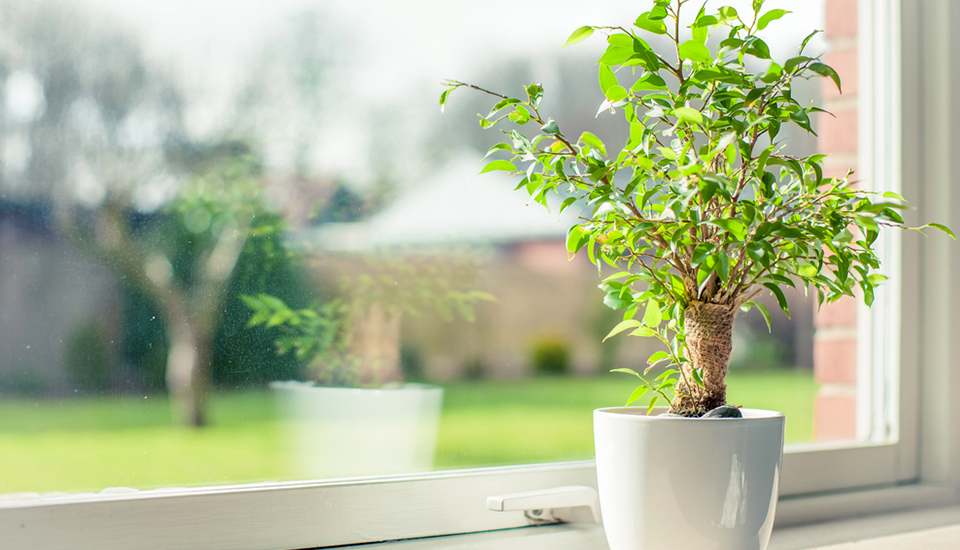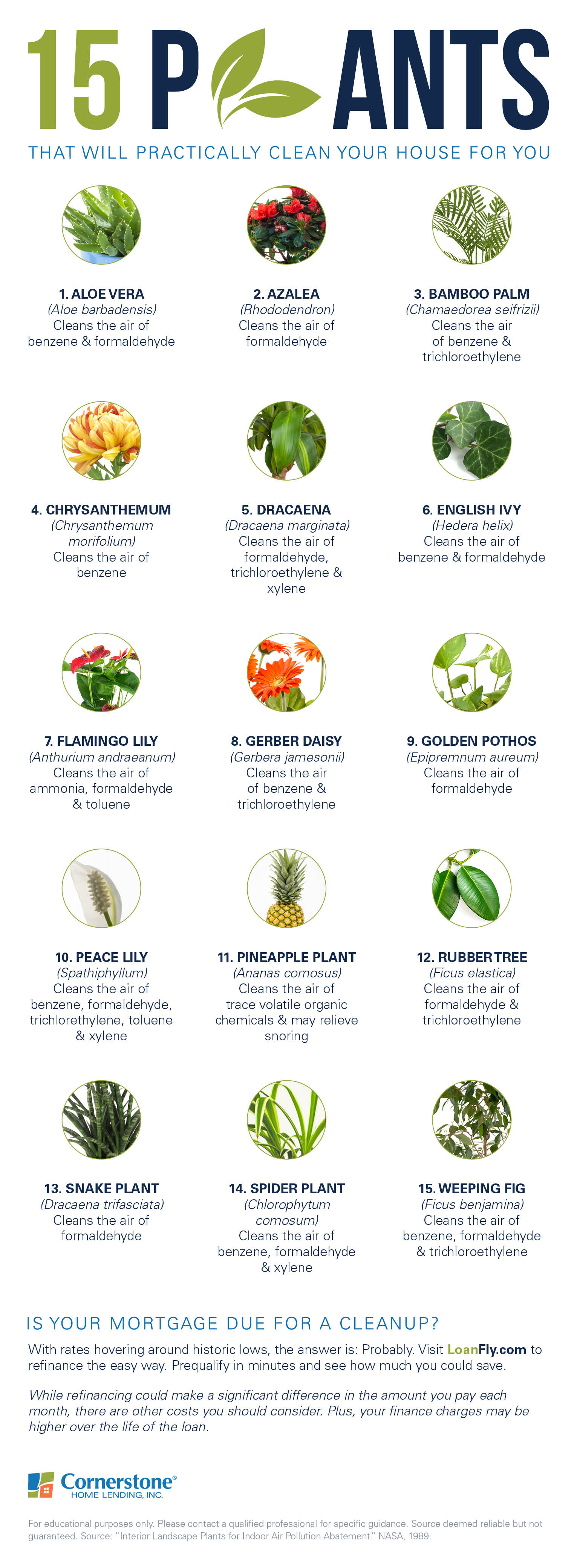Sure, plants can’t do the dishes or vacuum the carpet. But some plants are natural purifiers. Certain plants actually help clean the air in your home by filtering out contaminants that could put you and your family at risk.
Chemicals like benzene, formaldehyde, and trichloroethylene have been linked to cancer and other health problems. These toxins come from everyday items that we all use to make improvements to our home, so it’s helpful to consider substitutes and to keep purifying plant life around.
Plants to spruce up your space: 15 clean-air options
Many of our top picks come from NASA’s Clean Air Study, though newer studies have challenged these findings. Still, it can’t hurt to cultivate potentially protective plants, for aesthetics and until researchers agree on a conclusion. Air-cleaning plants also promote good feng shui as an added bonus.
To improve your indoor environment, get yourself some super-powered plants:
1. Aloe vera
This healing plant (Aloe barbadensis) does more than treat tiny cuts and burns. It’s great for clearing out the formaldehyde and benzene that come from your house cleaners and paints. Your aloe has your back: It’s also said to be an effective dust-absorber.
Best location: This dramatic plant would look nice next to a big, sunny window in your living room.
2. Azalea
An azalea (Rhododendron) can help you get rid of the formaldehyde that’s in your foam insulation or plywood. They’re at their prime at around 60 to 65 degrees, so make sure they’re not in direct sunlight.
Best location: These flowers would love to brighten up your entryway or chill in your basement.
3. Bamboo palm
You’ll love your bamboo palm (Chamaedorea seifrizii) more than any panda could once it starts filtering out the benzene and trichloroethylene in your carpeting and furniture. Give it some time, and it might also produce small (but inedible) berries and flowers.
Best location: Place your bamboo in your bedroom, next to your new dresser.
4. Chrysanthemum
These flowers (Chrysanthemum morifolium) are so beautiful, they’re often used for weddings. They can help you add color to your living space while they clear out the benzene that’s in plastic, paint, and glue.
Best location: Set this plant on a small table near a big window so it can soak up some sun.
5. English ivy
Amazingly, your English ivy (Hedera helix) can actually get rid of small particles of fecal matter in the air. Maybe this plant is so cute and cheerful-looking so it can distract you from what it’s really doing. In any case, it’s a lovely plant requiring little care. And it’s especially helpful if you have pets.
Best location: Put this plant on your toilet tank, next to a scented candle, and keep the soil moist.
6. Flamingo lily
Not only can it jazz up a room with its vibrant colors — flowering light and dark red, green, pink, and more — but it’s a low maintenance pick. Place your flamingo lily (Anthurium andraeanum) in indirect sunlight and water it a few times a week to potentially lower levels of airborne ammonia, formaldehyde, and toluene.
Best location: Lilies love humidity, so leave it on a windowsill in the bathroom or kitchen.
7. Gerber daisy
A Gerber daisy (Gerbera jamesonii) isn’t just bright and colorful. Its superpower is that it can filter out the trichloroethylene that floats off your dry cleaning. It can also get rid of the benzene that comes off your printer ink.
Best location: These cheerful flowers would look great on your dining or bedside table.
Save money when you clean up your mortgage. Our free calculator can tell you when refinancing pays.
8. Golden pothos
This hanging plant (Epipremnum aureum) stays bright green even in the darkest places. That’s probably why it’s nicknamed the “devil’s ivy.” Use it to filter formaldehyde sitting in your garage due to car exhaust. (Fun fact: Scientists genetically modified this houseplant in 2019, enabling it to better remove carcinogens.)
Best location: This guy is most comfortable in your garage.
9. Peace lily
Your peace lily (Spathiphyllum) is so easygoing. All it wants is for you to water it once a week and give peace a chance. What will your peace lily do for you in return? It’ll block out so many mega-toxins: formaldehyde, trichloroethylene, benzene, toluene, and xylene.
Best location: Place your peace lily in your bedroom so it can get shade and guide you in your most stressful moments.
10. Pineapple plant
It enhances air quality by producing plenty of oxygen, but could it also prevent snoring? NASA was rumored to endorse the tropical pineapple plant (Ananas comosus) as an anti-snoring solution in 2017, though actual reports are hard to find. Either way, the oxygen boost could help remove trace volatile organic chemicals, according to NASA’s earlier research.
Best location: Position this plant on your sunniest ‘sill, ideally south-facing, and remember to rotate it regularly.
11. Red-edged dracaena
What a complicated name for an uncomplicated plant. This reddish plant (Dracaena marginata) doesn’t need much watering or direct sunlight. It can powerfully filter out the xylene, trichloroethylene, and formaldehyde in household lacquers and varnishes.
Best location: Place your dracaena next to your freshly painted wall or refurbished vintage coffee table.
12. Rubber tree
It’s known for absorbing airborne chemicals and was originally cultivated in India. A rubber tree (Ficus elastica) can thrive in a small pot, as long as it’s near a source of light. It can be a great remover of trichloroethylene and formaldehyde, emitted from furniture and cleaning products.
Best location: Set this plant up in a spot with strong — but not too hot – sunlight; sheer curtains on a windowsill could help turn down the heat.
13. Snake plant
The snake plant (Dracaena trifasciata) has a hilarious nickname: “the mother-in-law’s tongue.” Maybe it’s named that because it’s so formidable. It filters out the formaldehyde in your harsh household cleaners. Did you know the toxin is also on your tissues, toilet paper, and personal care products? Easy to grow, even with some neglect, a snake plant is a keeper.
Best location: Your snake plant loves humidity and low lighting, so it’ll vibe in your bathroom.
14. Spider plant
If you want a houseplant that you really can’t kill, try a spider plant (Chlorophytum comosum). This guy is tough. It can filter out benzene, formaldehyde, carbon monoxide, and the xylene that’s used to make leather and rubber products. A spider plant is also pet-safe, for those who own a curious critter.
Best location: Your living room or your bedroom would be a great place to keep it.
15. Weeping fig
It only weeps because it gets sad when pollutants are in the air. Luckily, a weeping fig (Ficus benjamina) perks up when it starts filtering out formaldehyde, trichloroethylene, and benzene. These toxins are often in carpeting and furniture.
Best location: This plant will be happiest — with lots to consume — if your house is mostly carpeted.
Your mortgage could be due for a cleanup
With this diverse collection of indoor plants, your house is going to look a lot lusher and its air a lot cleaner. Why not do the same for your mortgage? Rates are still hovering around historic lows. It only takes a few minutes to prequalify and find out if refinancing could make your monthly payment cheaper.
While refinancing could make a significant difference in the amount you pay each month, there are other costs you should consider. Plus, your finance charges may be higher over the life of the loan.
For educational purposes only. Please contact your qualified professional for specific guidance.
Sources deemed reliable but not guaranteed.


